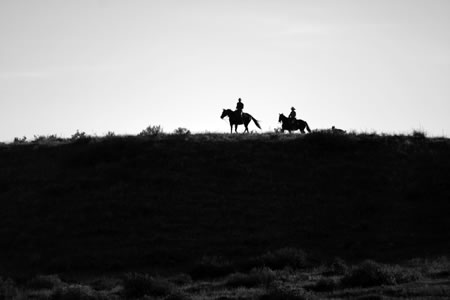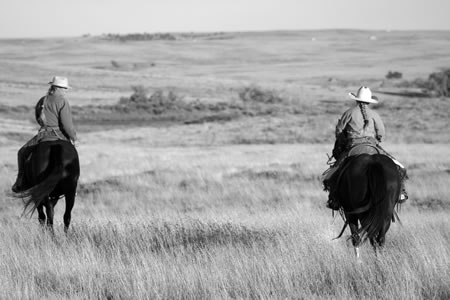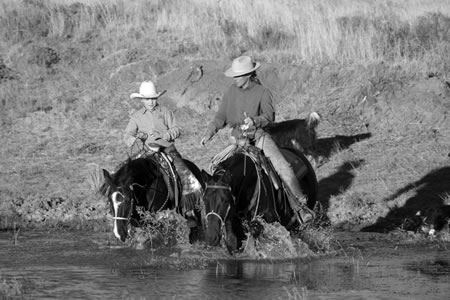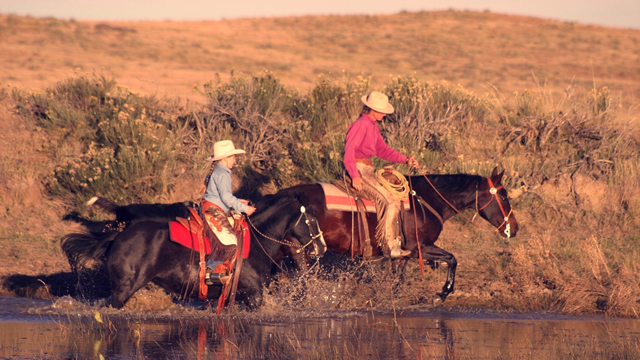Written by Sue Stuska Ed.D.
This article originally appeared in Eclectic Horseman Issue No.28
Riding outside over uneven terrain and around natural obstacles is a wonderful way to extend your training and is great fun. Riding out with others helps your horse to learn manners in company while letting you enjoy your friends. Whether trail riding is your usual activity or an occasional break, make it safe and enjoyable for you and your horse.
Equipment to Have With You
If you will be a distance from the barn, carry a simple first-aid kit including items of immediate nature like a human bandage, and carry a hoof pick (in case your horse picks up a rock). In areas where downed wire fences may be encountered, carry wire cutters/pliers. A cell phone can get help in an emergency: consider carrying it on your body in case you part company with your horse, but avoid carrying it on the back of your belt because you could hurt your spine if you fell on it.
If there is any chance of the weather getting wet or cold while you are out, carry a rain coat or jacket. Tie it securely to the saddle; jackets generally don’t stay put if you tie the arms around your body. The easiest way to keep control of your horse and the jacket at the same time is to dismount, make the change, and then remount. Before riding, get your horse comfortable with the noise and feel of the jacket flapping all around him. When you’re both experienced, you can make the change on the go.
Starting Out
Check your horse’s shoes. A shoe that loosens during an arena ride is not the same logistical problem as one that loosens many miles away from the barn. If your horse is barefoot, plan to travel over the appropriate terrain.
Plan ahead for good places to mount. Choose good footing away from overhangs and dangerous projections and stay a safe distance away from other horses.
It is better to ride with at least one other rider than to ride alone in case you need help. Regardless, let someone know where you are going and when you expect to return.
When riding with others, don’t ride off while someone is on foot. Waiting for the dismounted rider will help ensure that his/her horse pays attention and stands to be mounted.
Group Riding
Horses are such great followers that it’s easy to just go along and enjoy the ride. Do take long- or loose-rein breaks, but also keep communication with your horse. Consider it an addition to his training to hold his attention when he’d rather let it wander. Do things the others aren’t—go the other way around a tree or stop while they proceed.

Keep a safe distance behind the horse in front of you, and insist that others keep a safe distance behind you. Two horses’ lengths between horses works well at slow speeds. You can also gauge a safe following distance by looking over your horse’s ears: you should be able to see the hind hooves of the horse in front of you. A safe following distance keeps you out of kicking range, lets your horse see the trail ahead more clearly, and gives you plenty of time to stop when the horse in front of you does. As the speed increases, so should your following distance.
If you ride abreast, keep your knee across from the other rider’s knee. If, instead, you ride close to the other horse’s head, you may get bitten or the other horse/rider get kicked. For the same reasons, don’t ride up close to another horse’s haunches.
If you need to pass another horse, make sure the rider is aware that you plan to pass. Choose an open space with no obstructions along the trail that will force the horses close together. Pass wide enough to avoid a kick. Pass at a safe (slow) speed; walking around a standing horse is safest because both riders will be in the most control.
Avoid running up to or running by another horse that is moving more slowly. You might startle him, cause him to kick, incite bucking, or start a horse race.
The leaders should not increase the pace until everyone is ready. The horses at the end of the line will try to follow whether or not their riders are prepared (have their reins shortened, their horses’ attention).
The leaders should signal (a raised arm works well) before they stop or slow down; this gives the followers a chance to slow down in a balanced manner and avoid getting too close to the horse in front of them. Avoid using the horse in front of you for brakes.
Speed, Distance, Terrain
Keep your speed appropriate for the footing. It is up to you to keep your horse to a safe speed over rough ground, in mud or boggy spots, on snow, on pavement or going down hills. When in doubt, walk; if you are unsure of the footing, it may be best to take a different route. Look ahead for footing changes so you can slow down early. If you abruptly slow down in mud, for example, a sliding hoof can cause a pulled tendon. Cantering across an open field, or loping through the trees, is safer if you have first walked the route to check for new holes, muddy spots, or downed limbs.
In sensitive vegetation areas, stick to the trail rather than making a wide swath across the land. When using a switch-back trail, follow the path; never cut straight up or down a hill between switchbacks because erosion will surely result.
When riding with others, plan the trip with your horse’s physical condition in mind. It is great fun to go on long weekend rides with friends, and to do a lot of cantering, but if your horse is not in the appropriate condition, he is at risk for fatigue-related injuries. Monitor his condition throughout the trip and have an alternate plan if you need to turn back.

Rather than trying to finish a certain trail, consider how your ride is improving your horse’s training. Turning back because your horse won’t cross a river, and going home to work on water crossings, may be smarter than forcing the issue. Do set yourself up for success. Pick successively greater challenges that you think you can achieve, and enlist your friends to help you. Asking your green horse to follow a buddy quietly over a scary obstacle will increase his confidence that you will ask him to do safe things.
Always tailor the pace, terrain and length of the ride to the least able rider and the least fit horse. If you are in the lead, you have a responsibility to the others to maintain a reasonable and consistent pace. Watch the riders behind you. Too slow a pace will cause the horses to pile up behind you and get frustrated; too fast a pace will make it difficult for the end riders to keep a steady, sane pace. If less experienced riders/green horses are following you, pace your horse down/over and away from obstacles so their horses are not tempted to rush to catch up. If you are a less experienced rider or on a green horse, have a friend along who can stay with you when the others rush ahead (rather than taking the chance of getting out of control). Communicate with the other riders; it’s likely that they don’t realize how your horse is reacting but will slow down or take a different route if you ask.
Group riding games can be tailored to all abilities of horse and rider and be great training opportunities. For example, take turns leading, with each progressive leader turning back to walk along the line of horses and take up a position at the rear. Stretch the line out enough that a rider can weave left and right through the other horses. Or, have the last horse in line weave forward at a trot while others are walking.
On a long ride, if you get tired or sore, get off and walk for a while (or ride in two point/floating position, or drop your stirrups to rest your knees and ankles) instead of sitting in a way that will make your horse’s back sore. Avoid riding off to one side, sitting back on the cantle, or slumping; all of these distribute your weight in a way the saddle is not designed to carry and can make corresponding sore spots on your horse’s back.
The old adage of “walk the last mile home” still applies. It both cools down your horse and confirms his habit of walking home. Help youngsters and novice riders understand that, while it’s easier to get a horse going faster on the way back to the barn than it is going away, control must be present to make fast work safe. Horses learn very quickly that they can run back to the familiarity of their barn and can become unmanageable to their novice riders after just a few such runs. Don’t set this up to happen.
The horse that eats at will along the trail will make very slow progress and can choose inappropriate times to stop and eat. Eating during the ride is considered a bad habit in a horse (with the exception of competitive trail or endurance ride horses); riders should dictate when the horse may eat. Novice riders may think they are being nice to their horses by letting them eat, but after letting the horse choose for a while, it will be challenging for the novice to change the horse’s pattern. Consistency is easier for the horse and novice rider to understand, for example; grazing is not acceptable while mounted.
Loose Horses
When riding near pastured horses, the loose horses are likely to be curious and come over to investigate you. Stay out of their reach and keep your horse’s attention on you by keeping him busy. Avoid riding in the same enclosure with loose horses, if at all possible, until you are an experienced rider, as the loose horses may get your horse overly excited or come too close and cause a kicking accident.
If a rider lets go of his horse while dismounted, or if a fall occurs, do not chase the loose horse. Stand still; the loose horse will often stay near enough to the other horses to be caught by one rider, either mounted or on foot, at a walk. If the horse heads home, avoid the urge to chase after and “head him off.” A loose horse with a head start can outrun a mounted one; the pace and pathway can get out of hand quickly.
Obstacles
Choose the safest side of the road to ride on, given the shoulder situation, visibility for motorists, and how your horse may react to traffic. Ride in an alert fashion and keep your horse listening to you for guidance when vehicles approach.

When crossing roads, stop to listen and look both ways before walking across. With a group, have everyone cross at the same time to decrease the time spent in the potential path of a vehicle and give everyone his own line to follow if the need arises to hurry across. Plan your crossings so there is a safe pathway, well off the road, for all the riders once they cross.
Be alert but relaxed. If you sense that your horse might be bothered by something along the trail, get him listening to you and give him a job to do. Focus your eyes on something past the obstacle and ride right by. If you stare at the object, tense up, and quit riding, your horse is more likely to stop or shy.
Train ahead of time for water crossings. Work at stepping across small ditches so your horse will do that if you ask, rather than always jumping. There may be a time when the take-off or landing footing is too soft for jumping and you need him to step across. Use common sense when choosing places to cross. Be alert for pawing and that sinking feeling that your horse is going down in the water to roll—quickly get his attention and get him moving forward.
Particularly if the weather is hot, be sure your horse gets enough to drink during the ride. Exercise caution where multiple riders are letting their horses drink. Some horses will defend their water when they otherwise permit a buddy close by. Choose a safe place and time for your horse to enter the water. To make sure other horses get enough to drink, wait in a safe place on the other side for them to finish before moving away. The herd instinct is strong and may keep a thirsty horse from getting enough water if he feels he is going to be left behind.
Look ahead for low branches, protruding bushes and tree trunks. Take advantage of training opportunities to maneuver your horse wide around obstacles.
When riding single file, pass back trail information to the next rider. Holes, low branches and other hazards are easier to avoid when she is warned in advance. Sometimes it is best to brush by a protruding branch or vine rather than to reach out and hold it; the latter may result in it snapping back into the face of the next horse or rider.
Before jumping downed trees, etc., ride up to the obstacle and check for holes, rocks, branches and other hazards.

For the Future
Get permission to ride on private land. Respect the owner’s property (stay out of cultivated fields, off lawns, etc.). Pack out your trash. Carry out cigarette butts—this also prevents fires. Leave gates the way you found them—open or closed.
Support trail riding opportunities for now and the future. Consider contributing to preserve our remaining open spaces by joining an organization that promotes trail use, volunteering to work on trail maintenance, and supporting responsible trail use.
This article originally appeared in Eclectic Horseman Issue No.28


